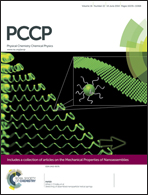Computer modeling of the complexes of Chlorin e6 with amphiphilic polymers†
Abstract
Recently it has been shown that Chlorin e6 (Ce6) when complexed with Pluronics (hydrophilic ethylene and propylene oxide block copolymers) and poly(N-vinylpyrrolidone) (PVP) exhibits considerably higher phototoxicity towards tumor cells than free Ce6. The present work aimed to model Ce6 interactions with hydrophilic Pluronic F127 and PVP and find out the nature of intermolecular forces stabilizing these complexes. Modeling included 3 steps: (i) application of molecular dynamics to study polymer folding using AMBER 8 program, (ii) evaluation of partial charges in the Ce6 molecule using different quantum mechanical, semi-empirical and topological approaches and (iii) docking analysis of Ce6 interactions with polymer coils using AUTODOCK 4.2. It was found that the folding in regular polymers does not occur stochastically, but involves the formation of “primary” helical structures, which further combined to form hairpin-like “secondary” structures. The latter in turn associated to form coils with minimal solvent accessible hydrophobic area. The Ce6 ring lies flat on the surface of the polymer coil at the interface between hydrophobic and hydrophilic regions. Calculations showed higher affinity of Ce6 for PVP in comparison to Pluronic and revealed marginal contribution of Coulomb forces to the stabilization of both complexes, which are mainly stabilized by van der Waals and hydrogen interactions.


 Please wait while we load your content...
Please wait while we load your content...